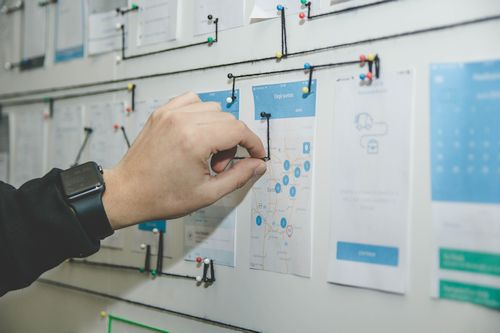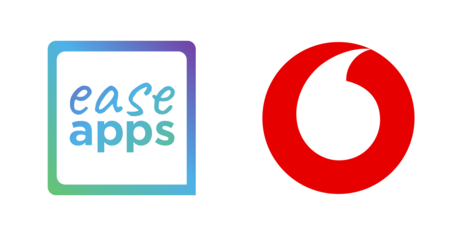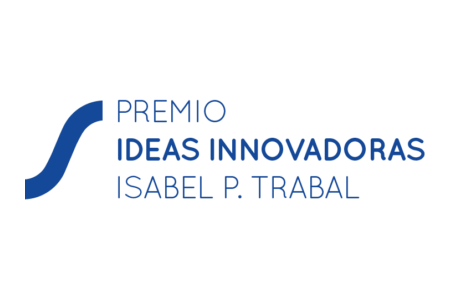In this post we unveil the challenges we face and how we address them when designing the user experience of our assistive technology products.
Developing an application is a complex task. Apart from the most technical issues, there is an essential aspect to take care during the design of any application: user experience.
As creators of applications that are going to be used by people, it is part of our job to try to offer the best possible user experience. And it is not just a matter of principle, it also has practical consequences. If an application is difficult to use, it will simply not be used.
Undoubtedly, our Ease Apps are far from perfect, but we are aware of the relevance of the user experience, even more when it comes to people with disabilities.
If you want to know the challenges we face and how we deal with them, continue reading.
User experience
User experience (UX) can be defined as the perception that a user has about our product or service. This perception is influenced by many factors. Some of these factors are related to the product design and everything that surrounds the product (purchase process, brand perception, customer service, etc.); other factors, however, are related to the idiosyncrasy of the person, the are the personal factors. As builders of solutions, we can hardly influence the latter, therefore, we should concentrate our efforts in the former.

Usability
A fundamental property to provide a good user experience is usability. Although there are numerous definitions of usability, we can say that a product is usable if is easy to learn and use.
Learnability is related to the ease for a new user to become productive with a system. Generally, we users are impatient and do not like to spend too much time learning how a system works, or solving puzzles. Therefore, being able to transfer the required knowledge and help users to start effectively is key to success.
Ease of use is related to how the product allow users to perform the task for which it was designed in an easy, efficient and intuitive way. When we use a system on a regular basis, we usually want to perform tasks faster, more naturally and with fewer steps.
Building a usable product typically involves a set of activities aimed at discovering the actual needs of users and using this information to continuously improve the system. These activities are usually performed during the whole lifecycle of the application, that is to say, during the design and development of the application, and once released.
Assistive technology design. The challenges.
If we consider building an assistive technology product that provides access, such as Ease Touch, Ease Mouse or Ease Joypad, in addition to the requirements above, it is needed to take into account a set of singularities which involves the development of this kind of systems.
Specific population
Most assistive technology products are aimed at people with a very specific functioning profile. In the case of Ease Apps, we are mainly targeting people whose basic common denominator is the difficulties using mobile devices with touch screens. More specifically:
- Ease Touch it is aimed at people with problems of fine mobility, manipulation or reach in upper extremities that prevents them from using a standard touch screen. Particularly, we think of people with precision problems, tremors, difficulty coordinating actions with multiple fingers simultaneously and slow movements.
- Ease Mouse and Ease Joypad also focus on people with mobility problems and for whom, most likely, the use of alternative access devices such as mice or joysticks has been previously assessed.
In many cases, the origin of these physical deficiencies are usually the result of disorders or other health conditions (for instance, cerebral palsy, Parkinson’s disease, neurodegenerative diseases, essential tremors, etc.). Such disorders often also impact on other body functions. For example, among people with cerebral palsy it is common to find other deficiencies related to mental and sensory functions.
This diversity of user profiles has a series of consequences for design:
- It is a challenge to establish a set of representative profiles that make user diversity more manageable and allows for the generalization of the test results.
- The number of people who can participate in usability tests is smaller compared to the design of products for mainstream markets. It is simply a matter of demographics.
- The tools need a significant degree of parameterization to suit this diversity of users. We address this issue a little later.
Specific interaction
Assistive technology for alternative access provides a specific interaction mechanism that differs from the conventional one. Take for instance a screen reader. A screen reader is an access system aimed at visually impaired people that presents the contents of the screen as voice or braille. The input is provided through the keyboard (or the touch screen for touch based devices). In contrast, regular computer access heavily relies on vision and direct manipulation of the objects on the screen.
Instead of vision impairments, Ease Apps deals with physical disabilities that prevents or greatly hinders the regular use of mobile devices. For example, Ease Touch avoids repetitive and involuntary actions by modifying the range of gestures that the touch panel accepts and provides indirect ways to perform such gestures. These alternative access mechanisms imply an additional level of complexity that needs to be described to the user. That is, specific interaction hinders learnability.
Intensive use
Throughout the day, an average smartphone user distributes her time between multiple apps: messaging, social networks, media player, notes, camera, calendar, browser, games, etc. Instead, an assistive technology product for access is used whenever the user interacts with the device. This fact adds more relevance to the ease of use of the solution.
Parameterization
The intensive use together with the heterogeneity of user profiles often requires a high degree of adaptation to fit the user’s needs. Therefore, this increases the number of configuration settings we have to add to the application (colors, sizes, times, thresholds, speeds, auditory responses, complexity of the user interface, etc.). This multiplicity of configurations adds complexity, which challenges learnability.
User-centered design
If you have read this far, congratulations, you know what the main challenges we face. But now, how to approach the design and development of such systems? Where lies the secret of usability and the quintessence of the design of products that delight users?
Well, the secret is that there is no secret, everything boils down to applying common sense and taking users into account throughout the process: observe their needs, make them part of the design process, ask them to test the applications, take their comments very seriously, etc. In other words, it consists in following a user-centered approach.

Users and stakeholders
So, if the user is the center, let’s center now on users. What is a user? A user is anyone who interacts directly with the system. In the case of Ease Apps, we distinguish two user roles:
- Recipients are people with disabilities for whom we design our systems and who will use them for interaction with mobile devices for specific purposes. We already dealt with their functioning profiles and the challenges these entail.
- Facilitators are responsible for installing and setting up the applications, and providing end-user support. Additionally, they usually act as prescribers and assessors of the suitability of the assistive technology. They are generally professionals working for disability care centers or related services, although they can also be other people close to the end user such as relatives or friends. In some occasions, the user herself might act as facilitator.
Although the profile of facilitators can be very heterogeneous, they would usually be people with experience in providing support to the end user, aware of their needs and with prior experience using mobile devices and some assistive technology products.
If facilitators are unable to understand how our system works, they would hardly recommend it to users and provide support to them. Therefore, it is crucial to involve them during the design process.
Of course, there are additional stakeholders such as other professionals, family members, colleagues, friends, etc. that can exert a decisive influence when adopting and encouraging or limiting the use of assistive technology. These can promptly acquire the role of facilitators, for example, to help start the smartphone or to adjust it to the wheelchair.
Devising the product
Many ideas emerge as a result of observing difficulties experienced by other people or oneself. In fact, this is how Ease Apps was born. Thanks to working close to people with disabilities we detected such difficulties spontaneously.
But detecting problems is only half the story. It is also necessary to conceive possible solutions to these problems. For this, it is necessary to know the options technology offers and how to adapt it to the user’s reality. Therefore, it is necessary to analyze how these users try to use technology, what is their functioning profiles, which difficulties they encounter in their day to day. It is also essential to know which tasks the user will want to perform, in which contexts, which support they will have and what other solutions exist in the market.
Design and development
Once the product is conceived, the next step is to transform the ideas into something tangible, in our case a computer application.
During this stage it is necessary to go back to the users on several occasions to contrast with them our progress and evaluate and validate it. These advances can be embodied in the form of sketches, schemes, prototypes, software versions, etc. It is an iterative incremental process where the information provided by the user is vital for its progress. This information is what allows us to detect problems as soon as possible, when fixing them it is simpler and economical.
In our case, we usually perform several usability tests using a modification of the technique called “thinking out loud”. This technique basically consists of:
- Recruit some representative users (recipients and facilitators).
- Ask them to perform some tasks with our prototype or application.
- Shut up, watch carefully and take notes of the most relevant facts while users use the system and verbalize what they think. Sometimes, we also record the session in video in case we need to resort to further information later.
Some participants in our tests have difficulties in articulating speech. In these cases we adapt the “thinking out loud” technique so that it is the facilitator who helps us interpret what the user tries to say, either orally or through other forms of expression. Another possibility we offer to the user is to interrupt the session at any time and express what she is thinking through their usual means of communication, for example, an augmentative or alternative communication (AAC) system.

Contexts of use and tasks
We distinguish between three situations or contexts:
- Getting started. In this context the facilitator is the only participant and the goal is to evaluate how hard is getting started with our system. Basically, the facilitator is given the name of the application and she has to find and install it, and understand how it works. Of course, it should be the first time the facilitator tries to accomplish such a goal. In this context, we are mainly interested on learnability.
- Structured context with external support. In this context, the user (recipient) usually requires intensive support to use the system successfully. This situation generally occurs within a care center (special education school, occupational workshop, day center or assisted living center).
Here we consider two types of tasks and both involve a facilitator and a recipient user.
- The first type consists of the facilitator trying to show an inexperienced user how the system works. With this we want to evaluate to what extent our system facilitates this knowledge transfer.
- The second type consists of a set of specific tasks the recipient user should perform. Usually, those tasks are chosen by the user. The facilitator must refrain from providing support, its sole role is to help the user expressing what is thinking when needed. With this type of test we want to see whether the system is easy to use.
- Unstructured context without external support. This is a more standardized context in which the user tries to fulfill her own needs and interests when using a mobile device. That is to say, is a regular context in which the user uses a mobile device on its own with almost no help from other people. In this case a usability test is not always carried out, only if we suspect that is needed. In fact, in some cases a message from the user or the facilitator is enough.
Release
The design and development of the software cannot last forever, hence at some point in time the application must be released. Granted, this first version contains imperfections and lacks some features, but it already fulfills a mission that we have verified in our tests with users.
We’re done? Not yet!
Firstly, we cannot consider the design process has finished until we have completed or discarded all those features we planned. Secondly, the publication of the application multiplies the possibilities of receiving comments, suggestions, support requests, etc. Thirdly, most of the people who have participated in the usability tests end up being users of our product and since we see some of these people regularly, we take the opportunity to follow up these cases.
Therefore, far from being finished, the release is a source of new ideas, modifications and tasks that accumulate to those that were pending and that will have to be properly prioritized to allow the evolution of the product to continue. Some of them will be modifications that can be easily validated by exchanging an email or a conversation in the hallway with a user. In other cases, the impact of the changes will be such that it will require a thorough review of the design and new usability tests sessions.
In short, user participation is essential throughout the life of the software.
Conclusions
Developing an interactive system taking care of the user experience is a complex task that, in the case of access-oriented assistive technology, exhibits particular challenges that must be faced.
The method we use to address this type of projects is based on a user-centered design approach. This basically consists of iterating through successive versions of the software with the participation of the end users. The main usability evaluation technique we use is called “thinking out loud” and it is adapted according to the characteristics of the participants with disability.
In addition to the final recipient, we consider the facilitator as a key figure in the process of adopting our applications. Thus, facilitators also take part on the software process.
Finally, the release of the application, far from finishing the design and development, provides new opportunities to increase its value over time.



